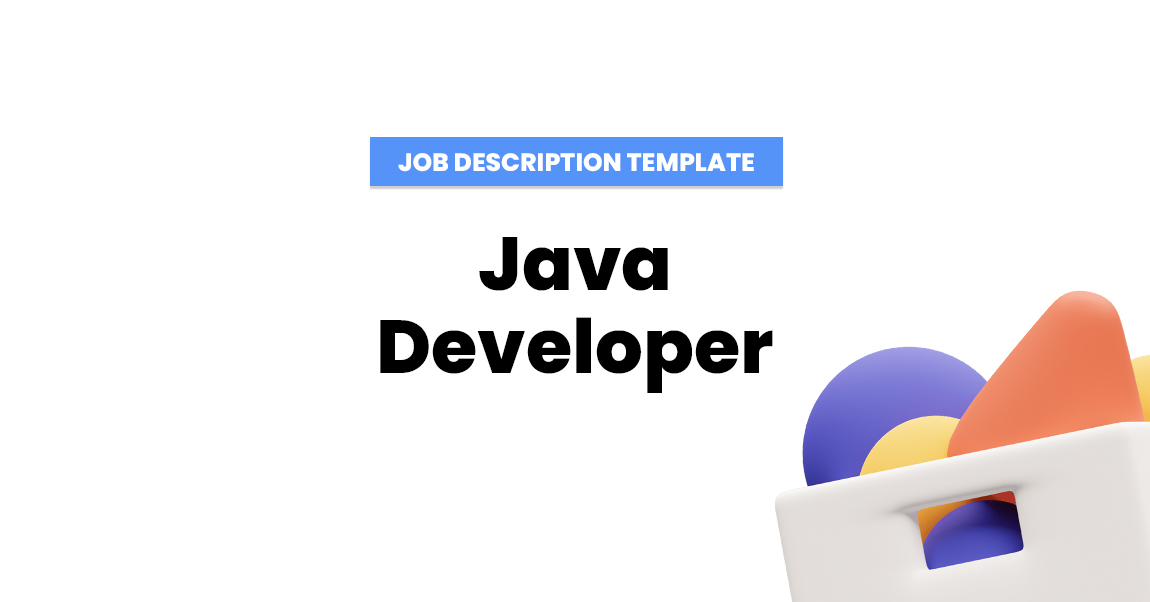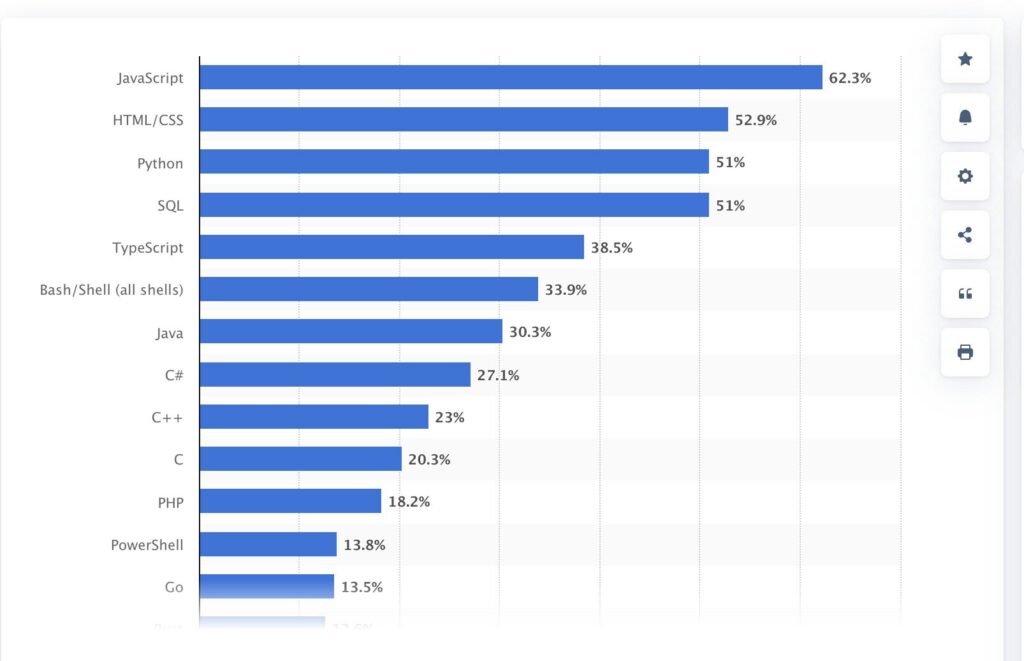Job Description Template
Java Developer Job Description Template

The reality in today’s tech landscape is clear: Java isn’t just surviving, it’s evolving at breakneck speed. With over 90% of Fortune 500 companies still running Java in 2025 and the language maintaining its position as the third most-used on the TIOBE Index, the question is whether your job description is attracting the right talent to hire a Java Developer.
While most companies are still writing job descriptions for yesterday’s Java developers, the role has fundamentally shifted. Modern Java development now centers around cloud-native applications, AI integration, and microservices architecture, yet many hiring managers are still screening for outdated Spring Framework knowledge from 2019.
Let’s rethink how you approach hiring a Java developer for 2025’s reality.
What Modern Java Development Actually Looks Like
Java in 2025 isn’t the same language it was even two years ago. With advances like GraalVM and Project Loom making it faster and more efficient, and Project Valhalla introducing value types for enhanced memory efficiency, today’s Java developers are working with significantly different tools and paradigms.
Here’s what we’re seeing in the current market:
Spring Boot remains the de facto standard for enterprise Java development, but it’s facing serious competition from Quarkus and Micronaut, particularly for cloud-native and Kubernetes deployments. The developers you want to hire understand these trade-offs and can articulate why they’d choose one framework over another based on your specific architecture needs.
Traditional application server deployments are giving way to containerized, cloud-native approaches with dramatically different performance profiles—Quarkus applications starting in 0.4 seconds versus traditional Tomcat’s 15-30 second startup times.

The Critical Skills Gap Most Companies Miss
Your microservices architecture needs more than just “Spring Boot experience.” Modern Java microservices require understanding of service mesh technologies, distributed tracing, and event-driven architectures. A developer who’s only worked with monolithic Spring applications will struggle with the complexity of managing inter-service communication, distributed logging, and eventual consistency patterns.
Native compilation with GraalVM is becoming essential for serverless deployments, reducing startup time by 50% and memory usage by 30%—yet most job descriptions don’t even mention this capability.
The reality about cloud integration: Companies are specifically seeking developers who understand containerization, Kubernetes orchestration, and cloud platform integration. Your “AWS experience preferred” requirement should be “Docker/Kubernetes required, AWS/Azure/GCP integration essential” if you’re serious about modern Java development.
Java Developer Job Description
Company Introduction Section
Transform your standard company blurb into a technical positioning statement that attracts forward-thinking developers:
“We’re building the next generation of [industry] solutions using modern Java architectures. Our engineering team leverages cloud-native patterns, event-driven microservices, and AI-integrated workflows to solve complex [specific problem]. If you’re excited about working with cutting-edge Java technologies like Project Loom’s virtual threads and GraalVM native compilation, let’s discuss how you can drive our technical evolution.”
Java Developer – Role Overview
We’re seeking a senior Java developer who understands that modern enterprise development means more than just writing Spring Boot applications. You’ll architect and implement cloud-native microservices, optimize for container deployment, and integrate AI/ML capabilities into our existing Java ecosystem.
This role requires someone who can evaluate trade-offs between Spring Boot, Quarkus, and Micronaut based on specific performance and deployment requirements, not someone who defaults to familiar frameworks regardless of the technical context.
Core Responsibilities (2025-Focused)
Architecture & Development:
- Design and implement microservices using modern Java frameworks optimized for cloud deployment
- Build reactive, event-driven systems using Spring WebFlux or equivalent reactive frameworks
- Optimize applications for containerized environments with focus on startup time and memory efficiency
- Implement observability patterns including distributed tracing, structured logging, and metrics collection
Performance & Scalability:
- Leverage Project Loom’s virtual threads for high-concurrency applications
- Implement efficient data processing pipelines using Apache Kafka or similar streaming technologies
- Design for eventual consistency in distributed systems
- Optimize JVM performance for cloud environments
Integration & Modernization:
- Integrate AI/ML models into existing Java applications using appropriate libraries and frameworks
- Implement Infrastructure as Code for Java application deployment
- Design and maintain CI/CD pipelines optimized for containerized Java applications
- Migrate legacy Java applications to cloud-native architectures
Technical Requirements (Market-Aligned)
Essential Experience:
- 4+ years of professional Java development with demonstrated progression to modern frameworks
- Production experience with containerized Java applications (Docker required, Kubernetes strongly preferred)
- Hands-on experience with at least two of: Spring Boot 3.x, Quarkus, Micronaut
- Understanding of reactive programming patterns and implementation experience
- Experience with cloud platforms (AWS, Azure, or GCP) including managed services integration
- Proficiency with modern Java testing frameworks and contract testing approaches
Advanced Capabilities:
- Experience with GraalVM native image compilation for performance-critical applications
- Understanding of Project Loom virtual threads and their appropriate use cases
- Event-driven architecture implementation using Apache Kafka or similar technologies
- Observability implementation using OpenTelemetry or equivalent frameworks
- Experience with service mesh technologies (Istio, Linkerd) or API gateway patterns
Emerging Technology Exposure:
- Integration experience with AI/ML libraries in Java (TensorFlow Java, DJL, or similar)
- Understanding of value types concepts from Project Valhalla
- Experience with modern build tools and dependency management
- Cloud-native security implementation patterns
What We’re Really Looking For
Beyond the technical checklist, we need someone who:
- Can articulate the trade-offs between different Java frameworks for specific use cases
- Understands that microservices introduce complexity around distributed systems, network latency, and data consistency
- Thinks in terms of system design, not just code implementation
- Stays current with Java evolution and can evaluate new technologies critically
- Has experience debugging distributed systems issues
Java Developer Interview Questions
Performing screenings and interviews with candidates are vital parts of the recruitment and hiring processes. Tech recruiters usually conduct the initial phone or online screening and provide the rest of the hiring team with the essential information regarding candidates’ knowledge and experience. However, tech staff still needs to conduct more thorough technical interviews.
Interviewing a Java Developer implies learning about their technical skills, previous experience, and motivation. These interviews are structured in such a manner to discover if a candidate is a cultural fit and if they possess strong technical knowledge. Many interviewers tend to ask questions regarding computer science fundamentals. They want to learn more about candidates’ familiarity with data structures and algorithms.
- “When would you choose Quarkus over Spring Boot for a new microservice?”
- “How do you handle data consistency across microservices boundaries?”
- “Describe your approach to optimizing Java applications for Kubernetes deployment”
- “What’s your experience with observability in distributed Java systems?”
Practical Architecture Scenarios: Present real challenges from your environment—not theoretical algorithm problems. Ask candidates to design solutions for your specific technical context.
Questions in regards to algorithms and data structures are often asked to find the intersection between candidates’ practical experience and their learning potential. However, these questions do not affect developers’ performance, and tech recruiters and interviewers only ask them to understand candidates’ knowledge, talent, and aspirations.
Questions about the professional working experience and career path, hands-on experience with specific technologies, tools, and frameworks, as well as some personality-related items are among the most commonly used types of Java Developer Interview questions.
The Competitive Reality
Java developer demand continues growing, with the field expected to grow 13% through 2028, but the supply of developers with modern Java skills hasn’t kept pace. Companies are offering competitive six-figure salaries for experienced Java developers who understand cloud-native development.
Here’s what most companies miss about the current market: The best Java developers aren’t looking for “Java developer” positions—they’re looking for “Senior Software Engineer” or “Principal Developer” roles that happen to use Java. Your job title and description should reflect the strategic nature of modern Java development.
Future-Proofing Your Hiring Process
Java remains one of the most in-demand programming languages, with new updates like Project Loom and Project Valhalla redefining its performance capabilities.
When hiring, emphasize not just core skills like Spring Boot and Hibernate, but also future-oriented expertise like cloud platforms, DevSecOps, and AI/ML integration. This ensures your job listing attracts forward-thinking developers who can grow with your company and drive technical innovation rather than just maintain existing systems.
The developers you want to hire understand that Java in 2025 means building intelligent, scalable systems that leverage the latest platform capabilities. Make sure your job description reflects this reality.
Ready to attract top Java talent? Our technical recruiting specialists understand the nuances of modern Java development and can help you identify candidates who bring both deep technical expertise and strategic thinking to your team. Let’s discuss how the evolving Java landscape impacts your specific hiring needs.